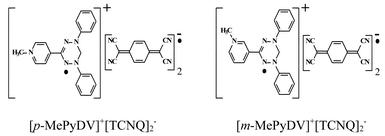Genuine organic magnetic semiconductors: electrical and magnetic properties of the TCNQ and iodide salts of methylpyridinium-substituted verdazyl radicals
Abstract
Two kinds of

* Corresponding authors
a
Department of Chemistry, Faculty of Science, Ehime University, Matsuyama, Japan
E-mail:
mukai@chem.sci.ehime-u.ac.jp
b Graduate School of Engineering, Kyoto University, Kyoto, Japan
c Institute for Molecular Science, Okazaki, Japan
Two kinds of

 Please wait while we load your content...
Something went wrong. Try again?
Please wait while we load your content...
Something went wrong. Try again?
K. Mukai, S. Jinno, Y. Shimobe, N. Azuma, M. Taniguchi, Y. Misaki, K. Tanaka, K. Inoue and Y. Hosokoshi, J. Mater. Chem., 2003, 13, 1614 DOI: 10.1039/B300029J
To request permission to reproduce material from this article, please go to the Copyright Clearance Center request page.
If you are an author contributing to an RSC publication, you do not need to request permission provided correct acknowledgement is given.
If you are the author of this article, you do not need to request permission to reproduce figures and diagrams provided correct acknowledgement is given. If you want to reproduce the whole article in a third-party publication (excluding your thesis/dissertation for which permission is not required) please go to the Copyright Clearance Center request page.
Read more about how to correctly acknowledge RSC content.
 Fetching data from CrossRef.
Fetching data from CrossRef.
This may take some time to load.
Loading related content
